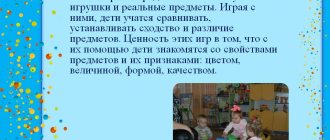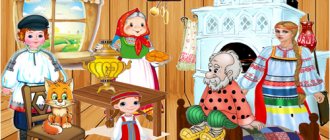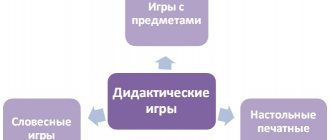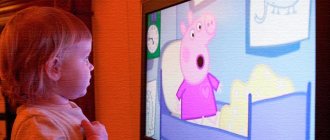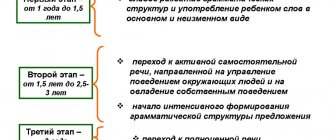Speech games with children: prepositions in, on, under, about. Games for children 3-4 years old.
Classes with children at home on speech development should be carried out in the form of interesting games that captivate both mother and children. Home speech games with three-year-old children are aimed at: 1) developing the child’s thinking, 2) enriching the baby’s vocabulary with new words, 3) developing a sense of language, 4) preventing grammatical errors, 5) developing the ability to coherently express one’s thoughts, 6) developing the articulatory apparatus for correct pronunciation of all sounds.
Normally, by the age of four, a child learns to correctly use the prepositions in, on, under, about, behind, before, between. But many children, in the absence of special speech activities and games, find it difficult to accurately use spatial prepositions and often confuse them (for example, they say “on the table” instead of “in the table” or simply say “here” and silently point with a finger, not knowing how to say correctly )
It’s easy to teach a child to use these prepositions correctly if you use speech games with children. All three- and four-year-old children love to play and learn very easily through play. One of my favorite games is hide and seek. This fun, entertaining game, known to all of us since childhood, will help parents teach preschoolers to correctly use the spatial prepositions IN, ON, UNDER, ABOUT in speech.
I offer a series of such home speech games from my gaming collection for conducting activities with children at home, in the country and on the road.
Game 1. Play hide and seek with Mishka
Pick up your child's favorite toy, such as a teddy bear. Invite your child to play hide and seek with the bear. Say: “We will hide candy (or a ball or any other object) from Mishka, and the bear will look for it.”
The bear closes its eyes (turn the toy’s muzzle towards the wall), while the child and I hide the candy. Then Mishka opens his eyes and starts looking for candy. IMPORTANT: at the same time, the bear seems to be talking to himself out loud and pointing with his paw to the right place: “Where did they put the candy? A! Probably on the table! No, not on the table. Under the table? Oh, and not under the table! Where did Dashenka (Vitenka, etc.) hide her from me? Maybe in the table??? Oh, and it’s not on the table... Maybe you can tell me where she is? A!!!! Near the table!!! Here she is!!!!" (The bear joyfully gives candy to the child)
In this game, the child only hears spatial prepositions in Mishka’s speech, but does not say them. A passive vocabulary is being accumulated. The speech game should be repeated on other days at the child’s request, but be sure to change its plot each time:
1) Change the object you are hiding and the toy each time. For example, a bunny can look for a real carrot, a doll for a bow, a dog for a bowl of food, etc. depending on what toys you have at home.
2) Each time, change the object in which you hide the secret for the toy:
- In a toy box, on a box, under a box, near a box
- In the bag, on the bag, under the bag, near the bag
- In the pencil case, on the pencil case, under the pencil case, near the pencil case
- In the buffet, on the buffet, under the buffet, near the buffet
- In the closet, on the closet, under the closet, near the closet.
Those. for the first time the bear was looking for candy on the table, under the table, etc. Next time the doll looks for the bow in the closet, on the closet, under the closet, etc. The third time the hippo looks for the ball on the bag, in the bag. In the fourth, the toy chicken is looking for its mother chicken, etc.
When repeating the game, the child will want to tell the character the location of the object, give him this opportunity. Only our character will not be very understanding. “Look under the box,” your son shouts. "A! Under the box, I’ll look now,” says the bunny. But he’s looking for something wrong - on the box. “Not on the box, but under the box,” the three-year-old child corrects. "A!!! “Got it,” says the bunny, and again makes a mistake, looking near the box. “You are looking near the box, but you should look under the box,” your child says sympathetically. And the bunny obeys him and finds the object. The task of the speech game is completed - the child has quietly learned to use these 4 prepositions correctly.
The technique of deliberate error is an excellent technique in conducting speech games with children on any topic. By correcting the hero and teaching him, children themselves quickly and easily learn the educational material.
How often should you conduct such activities with children at home? How long should they last? The duration of the game is usually 5 minutes.
If a child makes mistakes, then it is better to conduct speech play daily with different toys. The main principle is “it’s better to do it twice a day for 5 minutes than once a day for 10 minutes until you get tired.” The game must be stopped when the baby still wants to continue it.
Features of speech at 3-4 years
Speaking globally, the speech development of children now has the following characteristics.
- Intensive speech acquisition: growth of vocabulary, complication of speech structures, improvement of articulation.
- K.I. Chukovsky characterized this period as “brilliant linguistic talent”: now kids are actively engaged in word creation, creating the most unimaginable words and syntactic structures, trying to rhyme, composing poems, often understandable only to themselves.
- Children's speech is situational, that is, it is not prepared and is determined by a specific situation.
With a more detailed division, one can highlight the distinctive features in the improvement of various areas.
- Active vocabulary.
A child's vocabulary may consist of 1500–2000 words. At the same time, long or incomprehensible words are often distorted (“litekrichestvo” - electricity, “salamot” - airplane). The child can rearrange sounds or syllables in them (“paravachivay” - turn, “zvyat” - take, “gamazin” - shop). Now it is still difficult for the baby to pronounce sound combinations of two or more consonants. He can insert a vowel sound between them or skip half of the consonants (“drastuy” - hello, “zinayu” - I know).
- The grammatical structure of speech.
At 3 years old, a child’s phrases consist of 3-4 words; by 4 years old, he uses common sentences. Many kids can use complex and even complex constructions (Misha wants to eat, I’ll cook porridge. When summer comes, flowers bloom). Children begin to use simple homogeneous members in both singular and plural in their speech (I draw the sun and clouds. Geese swim and cackle). However, it may be difficult to form the plural of some words (mouths, trees). Children learn to use more parts of speech in conversation - adjectives, pronouns, adverbs, and numerals appear. But speech errors are still possible when coordinating the endings of adjectives and nouns, when changing verbs by persons and numbers.
- Phonetics.
The baby’s articulatory apparatus is gradually strengthening, he lisps less - he pronounces vowels without softening (“myasya” - meat, “syadik” - kindergarten). But phonetic errors are still possible that do not require special correction. For example, not being able to pronounce hissing words, a child replaces them with whistling ones (“sapka” - hat, “yezik” - hedgehog). The sounds [ts] and [h] are still “broken down into components” (“tsyplenok” - chicken, “tai” or “tsai” - tea). There are frequent problems with the pronunciation of sonorant [l] and [r]. They are either skipped altogether or replaced with [j], [l'], [v] (“ozhka” - spoon, “gavava” - head, “kiowa” - cow, “let” - mouth).
- Coherent speech.
Children 3–4 years old independently, without additional questions, cannot yet coherently and logically present what happened or saw, retell what adults read to them, or compose a complete story from a picture. They can only describe the objects depicted and the actions they perform (“This is a duckling. He is eating grass. There is a duck. This is his mother. She is standing and looking at the duckling”). But the kids are now actively remembering and reproducing various rhymes and nursery rhymes that they understand in their meaning.
- Intonation, expressiveness.
Children can now not only copy the shades of intonation that adults showed them when reading a poem, but also introduce their own expressive notes, which they think correspond to what they read. However, in the fourth year of life, children are not always able to adjust the tempo and volume of speech. They may not realize that they speak too quietly, especially when communicating with people they don't know well. And being strongly impressed by something, they talk about it, “choking on emotions,” confusedly and hastily.
Game 2. Kitten and dog
This game is one of my little students' favorites. We came up with it with 6-year-old children, but children from 3 to 10 years old and even their mothers play it with pleasure. This is one of the favorite games of parents and children on the road, in a queue or other place where they need to keep the baby occupied. Its undoubted advantage is that it does not require any special objects or space, and at the same time it is very interesting for children.
By the way, all games in this section can be played not only in Russian. When children grow up, they can be used to teach a foreign language.
We play this speech game like this.
1. The driver is selected. This is an adult or older child (5 years or more). He plays the role of a dog.
2. All participants in the game fold one palm into a fist. This is a house for a kitten. It doesn’t matter which hand will represent the house - the right or the left.
3. Show the index finger of the other hand. This is a kitten.
4. The kitten is small, he loves to jump. So he jumped onto the house (we put the index finger on the fist). Under the house (place your index finger under the house). Runs around the house (index finger near the fist). Suddenly a dog came running and barked “Woof-woof-woof”. Kitten - jump into the house! (the index finger must be quickly hidden in the fist before the dog grabs it). Dog - the leader tries to catch a kitten or kittens if several people are playing. If the presenter catches the kitten finger, then they change roles in the next game.
5. In the future, the driver’s commands in the game sound like this: to the house, under the house, near the house, into the house. When responding to the command “go to the house,” you must quickly hide your finger.
6. When repeating a speech game, you can deliberately confuse children. My favorite options:
- Speak rhythmically and slowly: na-pod-na-pod-na-pod, etc. many times (the child begins to rhythmically coax - repeat these words and loses vigilance due to monotony), and at this time you need to suddenly, unexpectedly for the child, say - “to the house!”
- Speak the command “to the house” sharply and quickly. The children begin to hide the kittens in the house. “Did I say to the house? There is no dog, the kitten is sitting on the house.” And immediately give the next command very softly and insinuatingly - “Into the house.” The child expects that the command to catch the kittens will be pronounced sharply and quickly, and most often does not have time to escape from the dog or manages to escape at the very last moment. This option teaches the child to focus on the content of words, and not on intonation.
- Alternating different game options is very intriguing for children. They always expect a trick from an adult and therefore listen very carefully to his words and follow his commands, which is what we need!
In this speech game, the child mainly only hears spatial prepositions and does not say them himself. But it must already execute commands correctly, i.e. relate the word and the position of the object. In the future, he can be given the role of leader. But here everything depends on the child’s characteristics: for a 3-year-old slow child, this role is not very suitable, but an active, nimble child will fulfill it with pleasure.
Working with children at home is always a joy for both adults and children. You cannot force a child to study, you need to carefully monitor him and make the games interesting and exciting. How to make activities and games fun for three-year-olds? My experience shows that the golden key to this will be playing games with the child’s favorite characters and favorite fairy tale plots. One kid will be happy to play with an ordinary bunny, another likes dinosaurs, and a third - Smeshariki. Use this key - and you will succeed!
In the third game we move on to the next stage - the active use in speech of the prepositions on, under, in, about.
Games for younger students
By the time they enter school, boys and girls communicate freely with other people on various topics. A child prepared for learning has a developed phonemic awareness, he can distinguish sounds in words, can correlate a sound with a sign and depict this sound. It is necessary to teach the student to construct texts, compose descriptions from pictures, work on the expressiveness of oral speech, on enriching the vocabulary, on competent writing.
At this stage, reading plays a huge role. If a child has previously been instilled with an interest in books, then he begins to read simple texts on his own, drawing cognitive and instructive information from there, developing memory and intelligence. Of course, if parents don't read, it's unlikely that their son or daughter will be interested in it.
"What if"
This game is suitable for both one child and a group of children.
For the game, you should prepare cards in advance with questions written on them in the form: “What would happen if?” The endings of the question should be like this:
- if all the adults disappeared;
- if night never came;
- if an elephant moved into our apartment;
- if there were no insects.
The cards should be laid out wrong side up. Ask your child to take out one card and think about the topic of the question.
Encourage your child to think outside the box
"Make Words"
On a large piece of paper (on the board) you need to write a long word (car, power plant, rock climber). Participants in the game need to create new words from the letters of this word. The winner is the one who comes up with the most new words.
"Let's make up a fairy tale"
The game requires several participants.
The first player comes up with the beginning of a fairy tale (one sentence). The next one adds his own. So all the participants in the chain come up with an interesting story.
"Stupid Suggestions"
The game requires at least two participants. One comes up with a word, and the second composes a sentence in which each word begins with the letters of the word that the first participant named. For example, the word “table” deciphers as “the dog was stomping around the boat.”
Invite the children to create their own fairy tales and funny stories.
Game 3. Riddles
Option 1
Place a box on the table and hide a few toys in the box, a few on the box, a few under the box, and a few items near the box.
Invite your child to guess your riddle. For example: “This toy is in a box. She's big." “It’s a ball!” the child guesses. After all, there are only two toys in the box - a large ball and a small bunny.
“Now tell me a riddle,” mom asks. “It’s on the box,” says a three-year-old child. You ask: “Is it long?” “No,” the kid answers. “Is it yellow or orange?” you ask. - "Orange". - "I guessed. Is this an orange?
In this game, the child is already required to accurately name the location of the object, using the necessary spatial preposition.
To make guessing more difficult, you can place more objects, selecting them of different colors, shapes, and sizes.
Your child will be happy to take part in arranging objects and asking you riddles - allow him to do this. By teaching you, the child learns himself! And a 3-year-old child learns great by asking riddles to a toy, especially if the toy is “unintelligible” and often makes mistakes. By correcting the toy's mistakes, the child will no longer make them himself!
Option 2
For a speech game, take 5 items. Place one on the box, two near the box, one in the box, one under the box. The child needs to remember where everything is. Cover your toys and the box with a blanket and ask the child: “Where is the hedgehog/squirrel, etc.” Make a riddle: “He is white, fluffy, with long ears. Where is he sitting? Remove the scarf or blanket and check. Having guessed, the child receives a toy.
The advantage of working with children at home, as opposed to working in a group of children, is that the mother can always adapt to the interests of the child and stay longer on what causes difficulties for him. If the child does not make mistakes in the words “under” and “about”, but is confused in the prepositions “on” and “in”, then in several games use only these two words that are difficult for the child until he stops making mistakes. And then enter all 4 words into the speech game.
